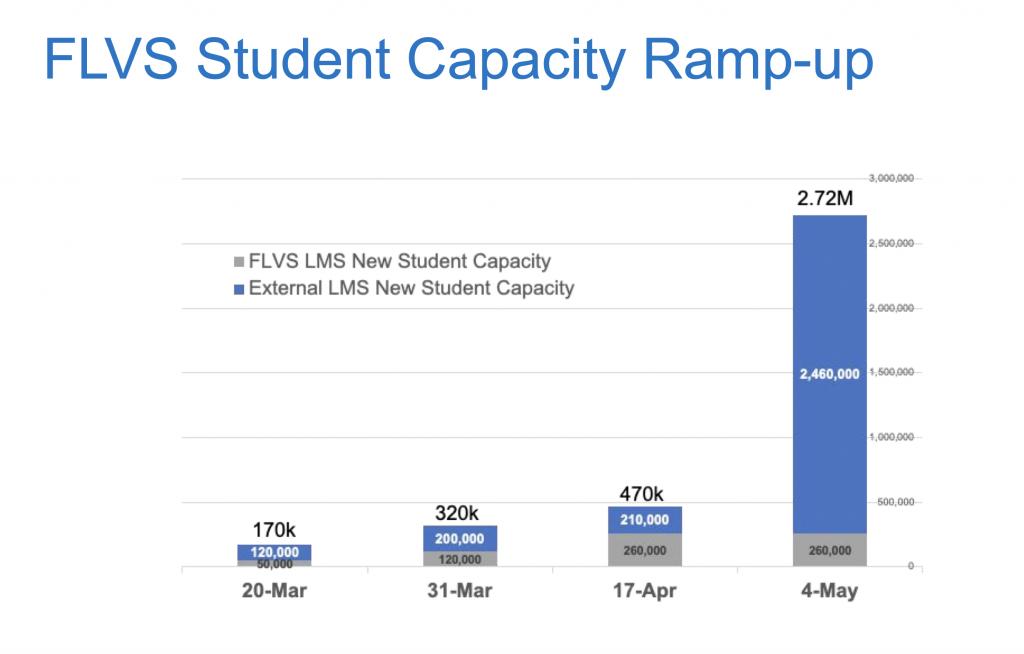Is the Plan to Replace Public Schools with FLVS? Asking for a Friend.
“You never let a serious crisis go to waste. And what I mean by that it’s an opportunity to do things you think you could not do before.” – Rahm Emanuel
The Florida Board of Education (FLBOE), which currently also serves as the Florida Virtual School Board of Trustees, met via a conference call on April 1st, 2020, following their regular FLBOE meeting. The conversation was “interesting.”
First, in his Commissioner’s report during the regular (telephonic) FLBOE meeting (listen at 1:00), Commissioner Corcoran thanked all those involved in what he called “the most massive pivot the world of education has ever seen,” continuing to provide the world class education students deserve, during the Covid-19 crisis. He informed the Board that Florida’s success in transitioning to distal learning was noticed by USDOE Secretary Betsy DeVos and VP Pence, who have called Florida “a leader in distance learning education,” noting that 9 other states have closed their schools entirely.
Corcoran also praised Florida Virtual School (FLVS) for “literally” training thousands of teachers to teach virtually, offering free classes to school districts and increasing their capacity, redirecting funds from their own budget, so that, come summer, they will be capable of serving the entire Florida student population (2.72 million) should the Covid-19 shut downs continue.
Hmmm, FLVS is ramping up so it can serve the entire Florida student population… why would we need to do that?
During the official FLVS Board of Trustees meeting, which immediately followed the FLBOE meeting, FLVS CEO Louis Algaze explained their Covid-19 Response plans:
- FLVS is in a unique position to support schools and teachers in an online learning environment to ensure students stay on track with their education despite potential Covid-19 disruptions.
- To support school districts across the state, FLVS developed Virtual Teacher Training for Covid-19, a 6 hour self-guided course designed to help brick and mortar teachers learn how to teach online. Currently 3,417 teachers have enrolled and 147 have completed the training. [So, they have “literally” trained 147, so far.]
- FLVS created and launched an online learning community, containing ideas, hints and advice on how to teach and learn online.
- FLVS has offered 100 digital courses free to all Florida schools (public, charter and private), through the end of the school year as an emergency service for grades K-12. His accompanying PowerPoint explained these free courses would be available from March 25, 2020 – June 30, 2020. [What will be the cost to districts after June 30th?]
- In order to make these courses available to all students, FLVS is spending $4.3 million of its reserves, ramping up their student capacity to ultimately serve 2.72 million students by May 4th.
- These offerings wouldn’t be possible without the support of the Commissioner of Education and the Board.
Board member Olenick asked about the increased capacity. Algaze responded:
“Beyond our system, we can support all of the students of Florida by just having the content available for all the school districts to access and get what they need in order to help them with their students if they… if there’s a need coming down the line here, at any time.”
Hmmm… “if there is a need coming down the line here, at any time.”
Board member Ben Gibson noted “Florida Virtual School is becoming more and more relevant and essential by the day…”
Later, during the FLVS meeting, the Board approved the plan to re-allocate $4.3 million from FLVS reserves to ramp up student capacity, with the goal of being able to serve 2.72 million students by May 4th, 2020. According to their June 30, 2019 Annual Financial report, also reviewed during the meeting, FLVS has a fund balance of $74,930,595, so $4.3 million is a drop in the bucket.

We have one simple question: “What is going on here?”
Why does Florida Virtual School, which currently serves 170,000 students and was in complete disarray less than a year ago, need the capacity to serve the entire Florida student body?
Currently, Florida’s teachers are making a herculean effort, transforming their classrooms to a digital learning environment in a matter of days, to allow students to stay at home and help #flatten the curve and save numerous lives. Our teachers are doing the work NOW. Courses available on May 4th will not be helpful this school year. Is the plan to transition Florida’s public schools to 100% FLVS courses next fall?
Edu-Blogger, Peter Greene, asks one big question:
“what the hell kind of education program only requires a technology upgrade to give itself a 1,300% capacity increase? That’s like suggesting that we can triple the capacity of a school by buying more desks. FLVS says its current teaching staff each serves about 162 students. Perhaps the plan is that the districts that sign up will have their own staff “teach” these courses that they did not design, assuming they can just familiarize themselves with the content, the software, etc, in the next couple of weeks.”
https://curmudgucation.blogspot.com/2020/04/fl-path-opens-to-killing-public-schools.html?spref=fb&fbclid=IwAR3XAI1l_ehlNdvqOeD8Zu6Ip-UALWtnABJKVLFFvacTJsOraYV51HvXf-A
Yes, that might be exactly what they have in mind.
Florida law (F.S. 1002.45) mandates that each Florida school district must provide a Virtual Instruction Program or VIP. “The purpose of the program is to make quality virtual instruction available to students using online and distance learning technology in the nontraditional classroom.” A school district’s virtual instruction program must include full-time and part-time virtual instruction for students enrolled in kindergarten through grade 12. Districts are given the option to contract with the Florida Virtual School or establish a franchise of the Florida Virtual School for the provision of their VIP. This is already in place in every Florida district. It appears that Commissioner Corcoran and the FLBOE are capitalizing on the Covid-19 crisis to expand such offerings… or are they anticipating the Covid crisis will continue into the next school year and expecting districts to jump to total virtual mode?
Free-market economist Milton Friedman once said “Only a crisis — actual or perceived — produces real change. When that crisis occurs, the actions that are taken depend on the ideas that are lying around.” The expansion of Florida Virtual School and the use of digital learning as “a transformative tool to disrupt the public education system” is an idea of Florida’s Ed Reformer-in-Chief, former Governor Jeb Bush, that has been “lying around” for quite some time. In 2010, he launched “Digital Learning Now!” which he promised would “unleash the power of digital learning.” What did Jeb see as the biggest obstacle to fully implementing his digital learning vision? “It’s not viewed as a core issue of learning. It’s viewed as a peripheral, and as such it always has the challenges of funding.”
The end of this story has not been written yet. What will public education look like in Florida following the pandemic? Will Covid-19 be the disruptive force that fulfills Jeb’s vision or will parents, students and teachers, after tolerating the social distancing necessary to suppress this pandemic, and making the best of the situation, flock back to their brick-and-mortar schools where their teachers will interact with students face-to-face?
Advocates of public education will need to continue to pay close attention. We cannot allow ourselves to be distracted enough by this crisis that we give so-called ed reformers the opportunity they have been waiting for: to completely disrupt our brick-and mortar-public schools.


3 Comments